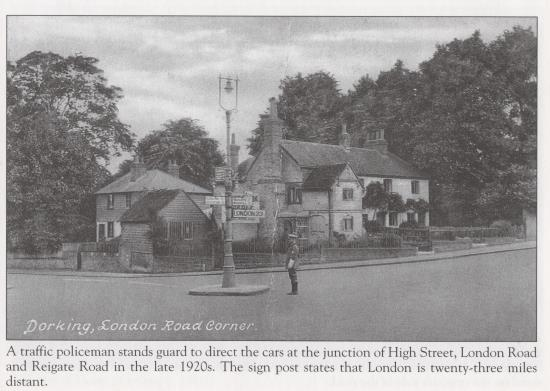
Living in the London Road from the early 1930’s, I have seen many significant changes that have taken place there. To demonstrate this I propose to take the reader on an imaginary journey back in time to the 1930’s along the Dorking section of this road.
We start at the junction at the east end of the High Street and Reigate Road where stood a RAC scout directing traffic from a small road island, where lights have now taken over this function.

Keeping to the east side of the road, there on the corner stood Orchard Cottage, which was separated into four units, each with its neat garden. In one of the porchways would be a collection of potted rock plants and fossil ammonites from the local chalk. A lady would sometimes be seen feeding her pet rabbits in their hutches. A boarded semi-detached was the next house down. All this has been demolished and replaced by the British Telecom Exchange.
Continuing on we passed Branscombe Cottage and came to Devonshire Cottage, a large white house shaded by trees in the front garden. These cottages have gone, and the area has been turned into a grass verge.
Further down was a wooden gateway to the kitchen garden belonging to Pippbrook House. Here the brick wall still stands to about twelve feet. Passing Pippbrook Gardens, comprising seven houses we reach Pippbrook House, formerly the Dorking Urban District Council Offices, now Dorking Library. There was a fine rock garden and a pond inside the grounds, but the Dorking Magistrates’ Court has now been built on this site.Next is the Pippbrook Service Station, which has remained as such as long as I can remember, although it has been extended and rebuilt on at least two occasions since. It now incorporates a retail shop.
We cross over the bottom end of Deepdene Avenue where it joins the London Road (now the A24). In the early 1930’s there was a small grass field here, surrounded by a hedge, the site of one of the estate lodges belonging to Deepdene House. Over the narrow brick bridge that crossed the Pipp Brook stream there stood on the right Brook House, a large old pebble-dashed building owned by the Apps family, who kept beehives in the garden. Now three houses have been built over the site, forming Brook Close.
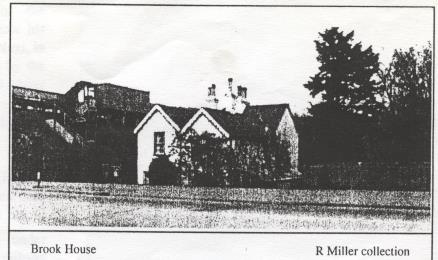
By Deepdene Railway Station the London Road passed under a narrow brick bridge carrying the Reading and Redhill railway line. During the last war anti-tank concrete blocks were erected as a barrier in the event of a German invasion.
Passing by six houses of varied design, erected at the turn of the century, we come to Lincoln Road, where there were once two small shops, namely Head’s, the bakers and general provisions store, who made daily deliveries of bread by pony cart, and Kewell’s Dairy. Both are now converted to private houses.
At the corner of Station Approach stands an hotel, built in a similar style to Dorking North Station, and at that period called the Star and Garter. Since then it has gone through many renovations, and is now called the Lincoln Arms. Next door was Kirby’s Station Approach Garage. Then came Harrison’s sweet shop and a café[1], followed by Longhurst & Pratt, Builders Merchants[2]. Apart from the hotel, all this side has been redeveloped, and now an office block, Redlands Roofing, occupies the site.
At the time of our imaginary journey Mr E C White, the Dorking North Station Master (1934 – 1938), lived with his family above the red brick-built station, which was demolished in 1975. The site has been redeveloped into a large office block for Biwater, incorporating a railway station entrance.
Returning towards London Road, on our right was the Dorking North Railway Goods Depot, where some deliveries were still being made with horse and cart. The site is now a car park.
Continuing north along London Road over the brick bridge of the railway line to London , we come at that time to a large field surrounded by a flint wall and fir trees, which was used for horse training. There is now a large office complex on the site belonging to Friends’ Provident. Crossing the entrance to Pixham Lane we come to Pixham Court, which was then the residence of Sir Malcolm Fraser. Next is Riverdale, with a stone lodge at its entrance.
Further on stands Beehive Cottage, a former public house. Next is a high brick wall where, when I was very young, there stood a rather ornate house connected with the till gate.
We now cross over to the western side of the road for the return journey. When the road was widened to ma dual carriageway in the 1960’s about four properties were demolished. A stone lodge stood at the entrance of a private road to Denbies House; next was Bradley Farm, now part of the Denbies wine estate. At the junction of Ashcombe and Chichester Roads stood an attractive mock-Tudor style bungalow.
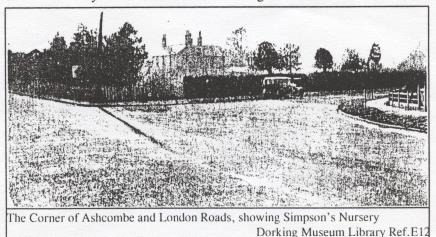
On the corner of Ashcombe Road was Simpson’s Nursery. Mr Simpson could often be seen making trade deliveries on his bicycle at the time. The site is now part of Ashcombe School.
At the south corner of the entrance to Croft Avenue was a house used by the office of Cubitt & West Estate Agents.
The caretaker made good use of the garden to grow his vegetables.
Next, in a large field by the Deepdene Railway line was a tennis court run by Dorking Lawn Tennis Club. Mowbray Gardens has since been built over the site.
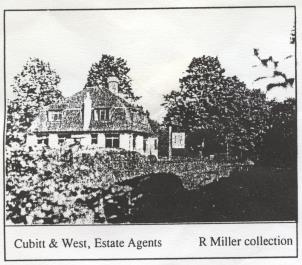
We return under Deepdene railway bridge, which was widened in steel and concrete to span the widened road in the 1960’s. The bridge over the Pipp Brook was rebuilt at the same time. Fairfield Road was in the process of being built during the 1930’s, and there was a grass field sloping down to Pipp Brook where Fairfield Court now stands.
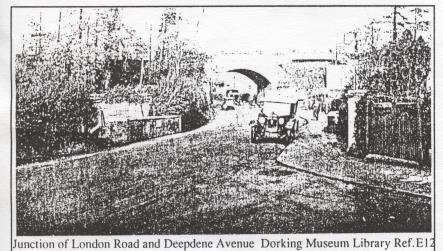
By the 1930’s Pippbrook watermill had just ceased working, and the buildings, now restored after a disastrous fire, have since been used for other purposes. The adjacent hill house was used during the last war by the Dorking ARP Rescue Unit, and is now a private hose. Near by stood Nash Motor Garage, since rebuilt and owned by R W Tutt (now Tutt’s Close).
We pass Tweenways, a brick house with a slate roof and triangular garden, and its neighbour, Rose Cottage, built of flint. Next is Rest Harrow, a period cottage with a “Surrey style” sandstone garden wall. Past the entrance to Rothes Road is a long flint and brick wall leading to a pair of large semi-detached houses. Highbank and Mayfield. All this section has remained largely unchanged.
We have now returned to our starting point. I trust that the tricks of time have not impaired my memories of London Road in the 1930’s.
[1] The little tea room adjunct to the sweetshop was busy mainly at weekends, when hordes of hikers poured from the station. Two ladies, tall Miss Ryder and small Miss Gibbs, served in the shop and café
[2] Longhurst and Pratt also had premises in Epsom, where they were chiefly known as funeral directors. Some 0f their memorial stone-working was carried out here in Dorking.